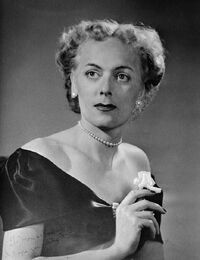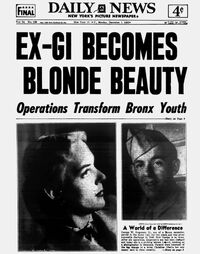Christine Jorgensen was an American transgender woman known for being the first person to become widely known in the United States for undergoing medical transition through gender confirmation surgery. Having learned about such surgery after her service in World War II, she traveled to Copenhagen and obtained special permission to undergo a series of operations beginning in 1952.[1]
When Jorgensen returned to the United States in the early 1950s, her transition became the subject of a New York Daily News front-page story, and she used the platform, her directness, and polished wit to advocate for transgender people in general. She often lectured on the experience of being transgender and published an autobiography in 1967. Jorgensen also worked as an actress and nightclub entertainer and recorded several songs.[2]
Early life[]
Jorgensen was born on May 30, 1926, in the Bronx, New York.[3] At an early age, Jorgensen became aware that she identified as female rather than her assigned gender at birth.[4] She wrote in American Weekly in 1953 that she hated boys' clothes and wondered why her clothes were so different from her older sister Dorothy's pretty dresses. In one of Jorgensen's early memories, she recalled questioning her identity to her mother: "'Mom,' I asked, 'why didn't God make us alike?' My mother gently explained that the world needed both men and women and there was no way of knowing before a baby was born whether it would be a boy or girl."[5]
Jorgensen's family was very close, and her grandmother became Jorgensen's biggest champion and supported her expressing her identity. In high school, Jorgensen developed an attraction to her male friends, but she knew at the time, she was not gay. Instead, she realized that she was a "woman trapped inside a man's body",[5]
As a teenager, Jorgensen said that she felt "lost between the sexes." She was more envious of girls than interested in them. Near the end of high school, Jorgensen found a diversion from her personal struggle — photography. Her father was an amateur photographer, and the two of them set up a darkroom at home. She also took classes at the New York Institute of Photography but had to put her photography interest aside when she was drafted into the military in 1945. Being small and slightly built, she ended up working as a clerk at Fort Dix, New Jersey.[3][5]
Transition[]

Headshot of Jorgensen
After Jorgensen's military service, she went to photography school in New Haven, Connecticut, and dental assistant school in New York City. Jorgensen was still unhappy with her life, however, and she began to look for answers in books. Reading The Male Hormone helped to understand how she was feeling, which led her to start taking estrogen, one of two main sex hormones that women have. She began to consult with doctors about surgeons in Europe who had already performed gender confirmation surgery. Determined to become a woman, she traveled to Denmark in 1950 to pursue her dreams.[3][5] There, she met Dr. Christian Hamburger,[5] an endocrinologist (a doctor specialized in hormones), who agreed to do the experimental procedure for free. He was the first person to diagnose Jorgensen as transsexual and not homosexual.
For the next two years, Jorgensen underwent hormone treatment, psychiatric evaluations, and finally surgery to remove her male genitalia.[5] To complete her transformation, she changed her name to Christine in honor of Dr. Hamburger's work of making her dreams come true. It was not until she returned to the United States, however, that Jorgensen received a surgically created vagina.[3][5]
Returning to America[]
| Please take note: | |
| This section contains mentions of transphobia and homophobia. Reader discretion is advised. |

New York Daily News' article
Upon Jorgensen's arrival home, her story reached the newspapers, and on December 1, 1952,[3] she made the front page of the New York Daily News under the headline "Ex-GI Becomes Blonde Beauty: Operations Transform Bronx Youth". In the following months, hundreds of newspapers featured her story, and she became an overnight sensation. The press and public's reaction came as a great shock to Jorgensen, who commented "I was surprised that everyone seemed very interested in my life ... time went on and I realized this was an important step in the eyes of the world."[5]
Like most members of the LGBTQIA+ community, Jorgensen experienced her share of hate and discrimination.[3][5] Six months after the media released her story, reporters reached out to surgeons involved in her transition to learn about the steps taken. The surgeons released the personal information that while Jorgensen had had her male genitalia, she did not have a vagina created, as had been assumed up until that moment.[5] Her supporters felt betrayed at the revelation and denounced her, claiming she could not be a woman without ovaries and other female reproductive organs. As Jorgensen avoided questions relating to her anatomy by focusing on her war background and physical appearance, the media soon shunned her and, according to author David Serlin, "exposed her as an 'altered male'-and, later, a 'morbid' transvestite ... Jorgensen was seen as nothing more than a limp wristed queer who indulged in activities culturally identified as female and therefore effeminate."[5] Jorgensen felt incomplete without female genitalia and underwent a vaginoplasty in May 1954; the procedure was performed by Dr. Joseph Angelo and Dr. Harry Benjamin.[5]
Later life[]
Jorgensen went on to be an entertainer and performed in many nightclubs. She wanted to be a Hollywood star, but never achieved that dream.[5]
She had several romantic relationships and was engaged twice but was denied a marriage license because her birth certificate identified her as male. To compound her struggles, one of Jorgensen's fiancés also lost his job when their engagement became known; however, she remained confident and optimistic about life, and in 1967, Jorgensen wrote an autobiography titled Christine Jorgensen: A Personal Autobiography. Throughout her life, she received thousands of letters, the majority being from others asking for help and guidance.[5]
Jorgensen retired to South California in the early 1970s, though continued to give lectures to students[5] and interviews on television. She died of bladder and lung cancer on May 3, 1989.[3][5]
Legacy[]
Even after her death, her story continues to resonate and offer hope for transgender veterans as they pursue their own self-fulfillment. Jorgensen concluded that "the answer to the problem must not lie in sleeping pills and suicides that look like accidents, or in jail sentences, but rather in life and freedom to live it".[3][5]
References[]
- ↑ 1.0 1.1 "25 Transgender People Who Influenced America". time.com. Time. (Archived on January 18, 2022).
- ↑ "Christine Jorgensen". queermusicheritage.com. Queer Music Heritage. (Archived on January 18, 2022).
- ↑ 3.0 3.1 3.2 3.3 3.4 3.5 3.6 3.7 "Christine Jorgensen Biography" (June 22, 2020). biography.com. Biography. (Archived on January 18, 2022).
- ↑ "Christine Jorgensen - Biography" (December 20, 2021). britannica.com. Britannica. (Archived on January 18, 2022).
- ↑ 5.00 5.01 5.02 5.03 5.04 5.05 5.06 5.07 5.08 5.09 5.10 5.11 5.12 5.13 5.14 5.15 5.16 "From GI Joe to GI Jane: Christine Jorgensen's Story" (June 30, 2020). nationalww2museum.org. The Nation WWII Museum. (Archived on January 18, 2022).
